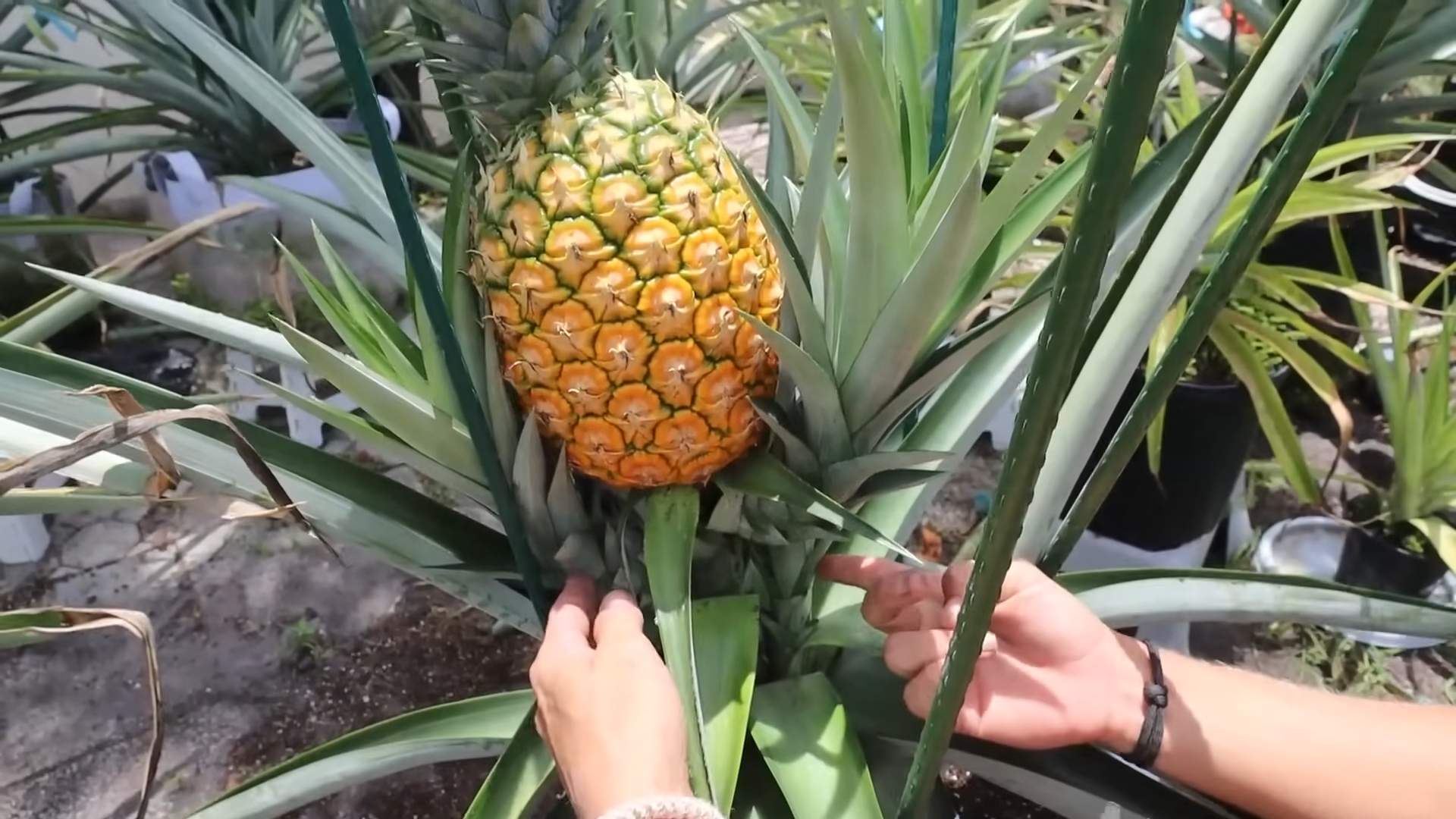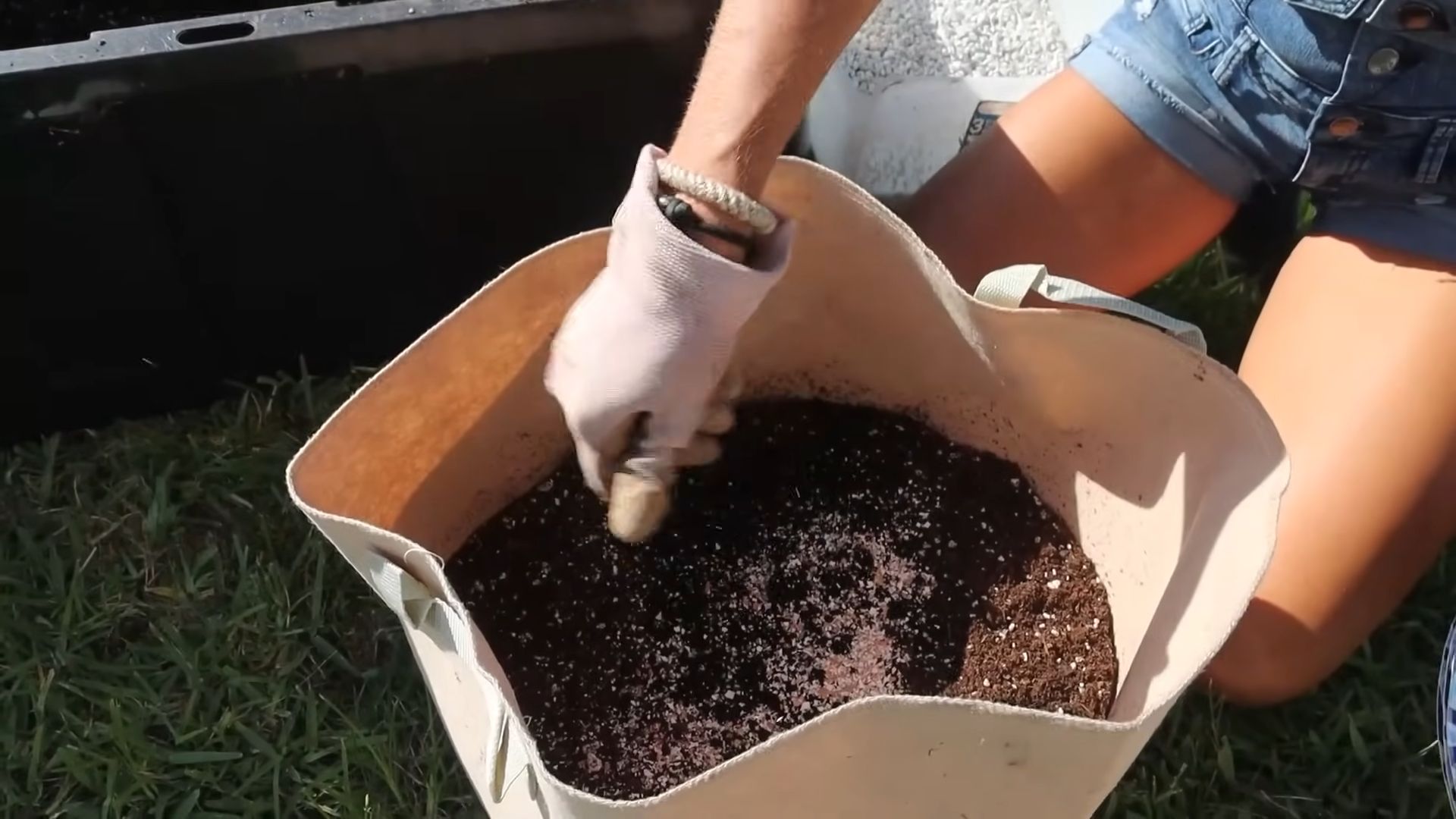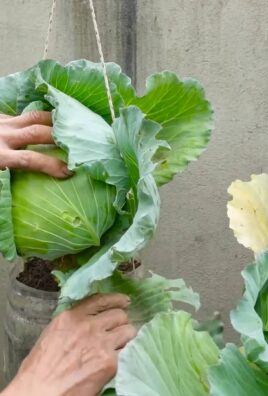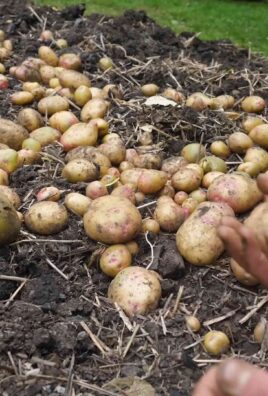Grow giant pineapples at home? Yes, you read that right! Imagine the look on your friends’ faces when you present them with a homegrown pineapple, bursting with tropical flavor and far surpassing anything you can find in the grocery store. This isn’t some far-fetched dream; it’s an achievable reality with a few simple tricks and a little bit of patience.
Pineapples, originally native to South America, have a rich history, symbolizing hospitality and luxury. In colonial times, displaying a pineapple was a sign of wealth and welcome. Now, you can bring that same sense of abundance and tropical charm to your own backyard, balcony, or even your living room!
Why should you embark on this DIY adventure? Well, store-bought pineapples, while delicious, often lack the intense sweetness and vibrant flavor of a freshly grown fruit. Plus, growing your own is incredibly rewarding and sustainable. You’ll know exactly where your food comes from, and you’ll be reducing your carbon footprint. I’m going to show you some easy-to-follow steps and share some insider secrets to help you grow giant pineapples at home, even if you don’t have a green thumb. Get ready to impress your neighbors and enjoy the sweetest, juiciest pineapples you’ve ever tasted!

Grow Giant Pineapples at Home: A DIY Guide
Hey there, fellow plant enthusiasts! Ever dreamt of harvesting your own juicy, oversized pineapple right in your backyard? Well, dream no more! I’m going to walk you through a surprisingly straightforward process to grow giant pineapples at home. It’s easier than you think, and the reward is absolutely delicious.
Choosing Your Pineapple Top
The first step to pineapple paradise is selecting the right starting material. You’ll need a healthy pineapple top – the leafy crown that sits atop the fruit.
* Look for a healthy pineapple: Choose a ripe pineapple from your local grocery store. The fruit should be fragrant and slightly soft to the touch. Avoid pineapples with bruises, soft spots, or signs of rot.
* Inspect the crown: The leaves should be vibrant green, firm, and free from pests or diseases. A slightly brown tip on some leaves is normal, but avoid crowns with widespread browning or wilting.
* Consider the variety: While any pineapple variety can be grown, some are naturally larger than others. Look for varieties like ‘Smooth Cayenne’ or ‘MD-2’ (Gold pineapple) if you’re aiming for a truly giant fruit.
Preparing the Pineapple Top for Planting
Now that you’ve got your pineapple top, it’s time to prepare it for planting. This involves removing the excess fruit and encouraging root growth.
1. Twist off the crown: Hold the pineapple firmly in one hand and the crown in the other. Twist the crown firmly until it separates from the fruit. You might need to use a bit of force, but be careful not to damage the base of the crown.
2. Remove the lower leaves: Carefully peel off the bottom few layers of leaves from the base of the crown. This will expose the root buds, which are small brown bumps that will eventually develop into roots. I usually remove about 1-2 inches of leaves.
3. Let it dry: This is a crucial step! Allow the pineapple top to dry out for 3-7 days. This helps to prevent rot and allows the cut end to callous over. Place the crown in a cool, dry place with good air circulation. I usually put mine on a paper towel in my garage.
4. Rooting in water (Optional): While you can plant the dried crown directly into soil, I’ve found that rooting it in water first gives it a head start. Place the base of the crown in a glass or jar of water, ensuring that only the bottom inch or two is submerged. Change the water every 2-3 days to prevent algae growth. You should see roots emerging within a few weeks.
Planting Your Pineapple Top
Once your pineapple top has either calloused over or developed roots in water, it’s time to plant it in soil.
1. Choose the right pot: Select a pot that is at least 10-12 inches in diameter. Pineapples need room to grow, and a larger pot will allow for better root development. Make sure the pot has drainage holes to prevent waterlogging.
2. Prepare the soil: Pineapples thrive in well-draining, slightly acidic soil. A mixture of potting soil, perlite, and peat moss works well. I usually use a ratio of 1:1:1. You can also add a slow-release fertilizer to the soil to provide nutrients.
3. Plant the crown: Fill the pot with the soil mixture, leaving a few inches of space at the top. Dig a hole in the center of the pot and carefully place the pineapple crown in the hole. Make sure the base of the crown is buried, but the leaves are above the soil. Gently pack the soil around the crown to secure it in place.
4. Water thoroughly: Water the newly planted pineapple crown thoroughly until water drains out of the drainage holes. This will help to settle the soil and provide moisture to the roots.
Caring for Your Pineapple Plant
Now that your pineapple is planted, it’s time to provide it with the care it needs to thrive.
* Sunlight: Pineapples need plenty of sunlight to grow. Place your pot in a location that receives at least 6-8 hours of direct sunlight per day. If you live in a climate with harsh summers, you may need to provide some afternoon shade to prevent the leaves from scorching.
* Watering: Water your pineapple plant regularly, but avoid overwatering. Allow the soil to dry out slightly between waterings. During the growing season (spring and summer), you may need to water more frequently than during the dormant season (fall and winter). I usually check the soil moisture by sticking my finger into the soil. If the top inch feels dry, it’s time to water.
* Fertilizing: Pineapples are heavy feeders and benefit from regular fertilization. Use a balanced fertilizer (e.g., 10-10-10) every 2-3 months during the growing season. You can also use a liquid fertilizer every few weeks. Follow the instructions on the fertilizer label for proper application rates.
* Temperature: Pineapples are tropical plants and prefer warm temperatures. They thrive in temperatures between 65°F and 85°F (18°C and 29°C). Protect your pineapple plant from frost and freezing temperatures. If you live in a cold climate, you may need to bring your pineapple plant indoors during the winter.
* Humidity: Pineapples also appreciate high humidity. If you live in a dry climate, you can increase the humidity around your pineapple plant by misting it regularly with water or placing a tray of water near the pot.
* Pest and disease control: Pineapples are relatively pest-resistant, but they can be susceptible to mealybugs, scale, and spider mites. Inspect your plant regularly for signs of pests and treat them promptly with insecticidal soap or neem oil. Root rot can also be a problem if the soil is not well-draining.
Encouraging Fruiting
Pineapples typically take 1-3 years to produce fruit, depending on the variety and growing conditions. Here are some tips to encourage fruiting:
1. Ethylene gas treatment: This is a common method used to induce flowering in pineapples. You can create ethylene gas by placing a ripe apple or banana near the pineapple plant and covering it with a plastic bag for a few days. The ethylene gas released by the fruit will stimulate flowering. I usually do this when the plant is at least 2-3 years old and has reached a good size.
2. Magnesium sulfate (Epsom salts): Epsom salts can help to promote flowering and fruit development. Dissolve 1 tablespoon of Epsom salts in 1 gallon of water and apply it to the soil around the pineapple plant every month during the growing season.
3. Watering with diluted seaweed extract: Seaweed extract is a natural source of plant hormones and nutrients that can help to stimulate flowering. Dilute the seaweed extract according to the instructions on the label and use it to water your pineapple plant every few weeks.
Harvesting Your Pineapple
Once your pineapple fruit has developed, it’s time to harvest it.
* Check for ripeness: A ripe pineapple will have a fragrant aroma and a slightly soft feel. The color of the fruit will also change from green to yellow or golden.
* Harvesting: Use a sharp knife to cut the pineapple fruit from the plant. Leave a few inches of stem attached to the fruit.
* Enjoy! Your homegrown pineapple is now ready to enjoy! You can eat it fresh, use it in smoothies, or grill it for a delicious treat.
Troubleshooting
* Yellowing leaves: This can be caused by overwatering, underwatering, nutrient deficiency, or pest infestation. Check the soil moisture and adjust your watering accordingly. Fertilize your plant regularly and inspect it for pests.
* Brown leaf tips: This can be caused by dry air, sunburn, or salt buildup in the soil. Increase the humidity around your plant, provide some afternoon shade, and flush the soil with water to remove excess salts.
* No fruit production: This can be caused by insufficient sunlight, lack of nutrients, or improper watering. Ensure that your plant receives at least 6-8 hours of direct sunlight per day, fertilize it regularly, and water it properly. You may also need to try the ethylene gas treatment to induce flowering.
* Slow growth: This can be caused by poor soil, insufficient sunlight, or low temperatures. Repot your plant in well-draining soil, provide it with plenty of sunlight, and keep it warm.
Tips for Growing Giant Pineapples
* Choose the right variety: As mentioned earlier, some pineapple varieties are naturally larger than others. ‘Smooth Cayenne’ and ‘MD-2’ are good choices for growing giant pineapples.
* Provide ample space: Pineapples need plenty of room to grow, so make sure to plant them in a large pot or in the ground.
* Fertilize regularly: Pineapples are heavy feeders and need regular fertilization to produce large, healthy fruit.
* Water deeply:

Conclusion
So, there you have it! Growing giant pineapples at home isn’t just a whimsical dream; it’s an achievable reality with a little patience, the right techniques, and a whole lot of sunshine. We’ve walked you through the process, from selecting the perfect pineapple top to nurturing your plant to its full, glorious potential. But why should you embark on this tropical adventure?
First and foremost, the satisfaction of harvesting a pineapple you’ve personally cultivated is unparalleled. Forget the bland, mass-produced fruit from the grocery store. Homegrown pineapples boast an intense sweetness and vibrant flavor that will redefine your perception of this tropical delight. Imagine the look on your friends’ faces when you present them with a slice of your own giant pineapple!
Beyond the taste, growing your own pineapple is a sustainable and rewarding endeavor. You’re reducing your carbon footprint by eliminating the need for long-distance transportation, and you’re connecting with nature in a meaningful way. Plus, pineapple plants are surprisingly beautiful, adding a touch of exotic charm to your garden or indoor space.
But let’s talk about variations. While we’ve focused on the traditional method of rooting a pineapple top, don’t be afraid to experiment! Some gardeners have success with planting pineapple slips (the small plantlets that sometimes grow around the base of the fruit). Others have even tried growing pineapples from seed, although this method requires significantly more patience.
Consider the variety of pineapple you choose. While Smooth Cayenne is a popular choice for its size and flavor, other varieties like Sugarloaf or Red Spanish might be better suited to your climate or personal preferences. Research different pineapple cultivars and select one that thrives in your region.
And don’t limit yourself to growing just one pineapple! Once your plant matures and produces fruit, you can harvest the top and start the process all over again. Before you know it, you’ll have a thriving pineapple patch, providing you with a continuous supply of delicious, homegrown fruit.
Now, we understand that growing giant pineapples at home can seem daunting at first. But with our step-by-step guide and a little bit of dedication, you’ll be well on your way to enjoying your own tropical bounty. Remember to provide your plant with plenty of sunlight, well-draining soil, and regular watering. And don’t be afraid to ask for help or advice from experienced gardeners in your area.
We truly believe that anyone can grow a giant pineapple at home, regardless of their gardening experience. It’s a fun, educational, and ultimately rewarding project that will bring joy to your life and delicious fruit to your table.
So, what are you waiting for? Grab a pineapple, follow our instructions, and get ready to embark on your own tropical adventure. And once you’ve harvested your first giant pineapple, be sure to share your experience with us! We’d love to see your photos, hear your stories, and learn from your successes (and even your failures). Together, we can create a community of pineapple enthusiasts, sharing our knowledge and passion for this amazing fruit. Let’s get growing!
Frequently Asked Questions (FAQ)
How long does it take to grow a giant pineapple?
Patience is key when growing pineapples! From planting the top to harvesting a mature fruit, it typically takes anywhere from 2 to 3 years. The exact timeframe depends on factors such as climate, sunlight exposure, soil quality, and the specific pineapple variety. Don’t be discouraged if your pineapple takes longer than expected; the wait will be well worth it!
What kind of soil is best for growing pineapples?
Pineapples thrive in well-draining, slightly acidic soil. A sandy loam is ideal, as it allows for good drainage and aeration. You can amend your soil with organic matter such as compost or peat moss to improve its drainage and fertility. Avoid heavy clay soils, as they can retain too much moisture and lead to root rot. A soil pH between 5.5 and 6.5 is optimal for pineapple growth.
How much sunlight do pineapples need?
Pineapples are sun-loving plants and require at least 6 to 8 hours of direct sunlight per day. If you’re growing your pineapple indoors, place it near a sunny window or supplement with artificial grow lights. Insufficient sunlight can result in stunted growth and reduced fruit production.
How often should I water my pineapple plant?
Water your pineapple plant regularly, especially during the growing season (spring and summer). Allow the soil to dry out slightly between waterings. Avoid overwatering, as this can lead to root rot. In the winter, reduce watering frequency as the plant’s growth slows down. A good rule of thumb is to water when the top inch of soil feels dry to the touch.
Do I need to fertilize my pineapple plant?
Yes, fertilizing your pineapple plant is essential for healthy growth and fruit production. Use a balanced fertilizer (e.g., 10-10-10) diluted to half strength. Apply the fertilizer every 2 to 3 months during the growing season. Avoid fertilizing during the winter months when the plant is dormant. You can also use organic fertilizers such as compost tea or fish emulsion.
How do I know when my pineapple is ripe?
Determining when a pineapple is ripe can be tricky, but there are several indicators to look for. The pineapple should have a vibrant color, ranging from green to golden yellow depending on the variety. The fruit should also have a sweet, fragrant aroma. Gently tug on one of the leaves; if it comes off easily, the pineapple is likely ripe. You can also tap the pineapple; a ripe pineapple will have a dull, thudding sound.
Can I grow a pineapple indoors?
Yes, you can successfully grow a pineapple indoors, provided you meet its basic needs. Choose a large pot with good drainage and fill it with well-draining soil. Place the pot in a sunny location or supplement with artificial grow lights. Water regularly and fertilize every 2 to 3 months. Be aware that indoor-grown pineapples may take longer to mature and may not reach the same size as those grown outdoors.
What are some common pests and diseases that affect pineapples?
Pineapples are relatively pest-resistant, but they can be susceptible to certain pests and diseases. Mealybugs, scale insects, and spider mites can sometimes infest pineapple plants. These pests can be controlled with insecticidal soap or neem oil. Root rot is a common disease that can occur in poorly drained soil. Prevent root rot by ensuring good drainage and avoiding overwatering.
Can I eat the core of the pineapple?
Yes, the core of the pineapple is edible, although it is tougher and less sweet than the flesh. The core contains bromelain, an enzyme that has anti-inflammatory properties. Some people enjoy eating the core raw, while others prefer to cook it or add it to smoothies.
What can I do with the pineapple leaves after harvesting the fruit?
Don’t throw away those pineapple leaves! They can be used for a variety of purposes. You can compost them to enrich your garden soil. You can also use them to make pineapple leaf fiber, which can be woven into textiles. Some people even use pineapple leaves to make tea. Get creative and find new ways to utilize this valuable resource!





Leave a Comment